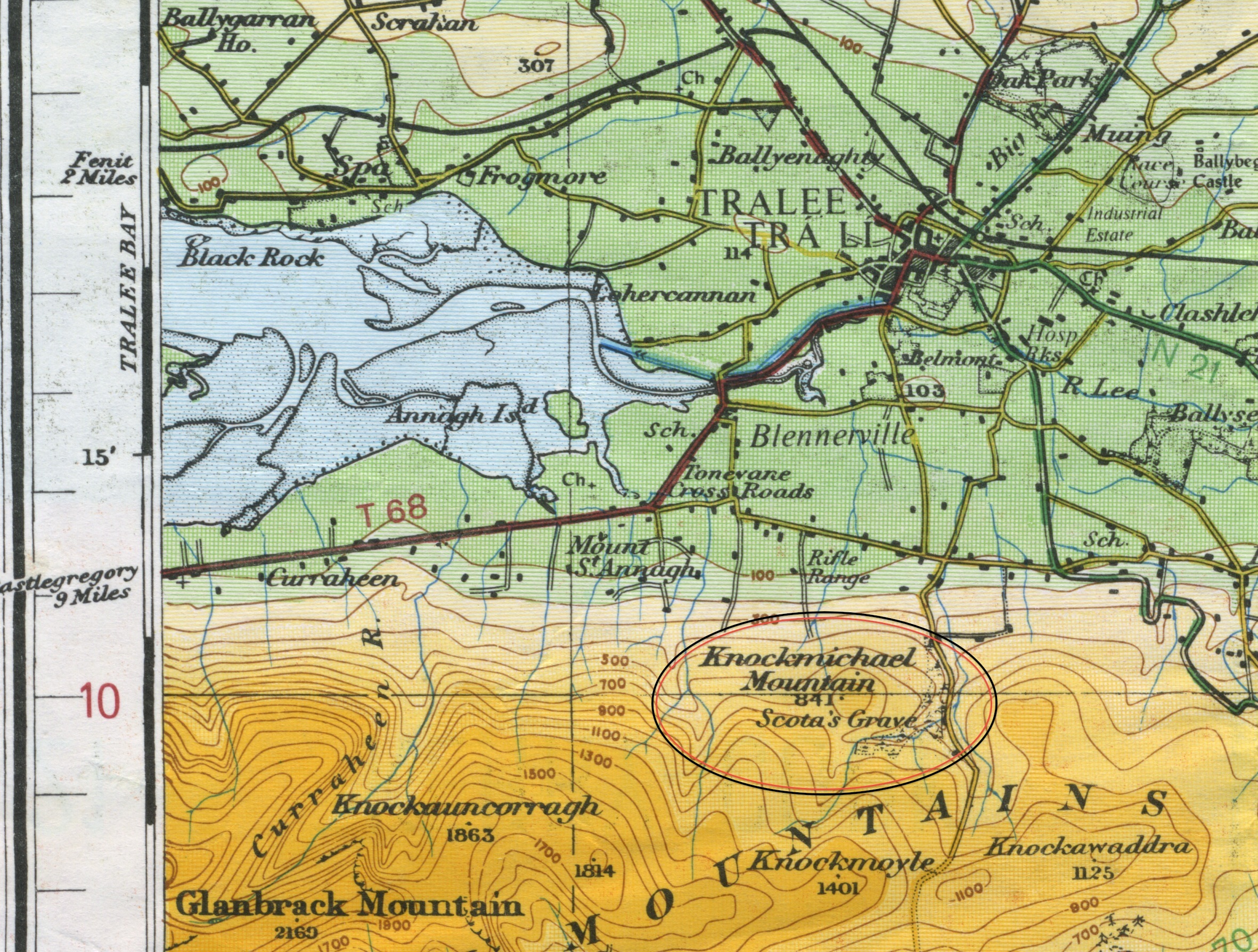Scotia's Grave on:
[Wikipedia]
[Google]
[Amazon]
Scotia's Grave ( ga, Gleann Scoṫín , translation=Glen of 
{{cite book , author=Maeve Friel , title=Here Lies: A Guide to Irish Graves , publisher=Poolbeg , date=1997 , isbn=1-85371-713-4 , page=156
Geography of County Kerry
Tourist attractions in County Kerry
Irish legends
Scotia
Scotia is a Latin placename derived from ''Scoti'', a Latin name for the Gaels, first attested in the late 3rd century.Duffy, Seán. ''Medieval Ireland: An Encyclopedia''. Routledge, 2005. p.698 The Romans referred to Ireland as "Scotia" around ...
) is an area just south of Tralee
Tralee ( ; ga, Trá Lí, ; formerly , meaning 'strand of the Lee River') is the county town of County Kerry in the south-west of Ireland. The town is on the northern side of the neck of the Dingle Peninsula, and is the largest town in Count ...
in County Kerry beside the Finglas rivulet
A stream is a continuous body of surface water flowing within the bed and banks of a channel. Depending on its location or certain characteristics, a stream may be referred to by a variety of local or regional names. Long large streams ar ...
in Trughanacmy
Trughanacmy ( gle, Triúcha an Aicme) is a barony in County Kerry, Ireland. The barony is an obsolete administrative area, having ceased to have any government function since the enactment of the Local Government (Ireland) Act 1898.
In 1881 the ...
. It marks what is reputed to be the grave of Scotia
Scotia is a Latin placename derived from ''Scoti'', a Latin name for the Gaels, first attested in the late 3rd century.Duffy, Seán. ''Medieval Ireland: An Encyclopedia''. Routledge, 2005. p.698 The Romans referred to Ireland as "Scotia" around ...
, a daughter of an Egyptian Pharaoh
Pharaoh (, ; Egyptian: '' pr ꜥꜣ''; cop, , Pǝrro; Biblical Hebrew: ''Parʿō'') is the vernacular term often used by modern authors for the kings of ancient Egypt who ruled as monarchs from the First Dynasty (c. 3150 BC) until the ...
known as Friel. The traditional name of the location is Glenn Scoithin, 'vale of the little flower' or 'wee blossom.' "Scoithín" is the diminutive of "Scoṫ," (the 't' may be aspirated as ṫ). Scotland's name comes from the Irish language, and refers to the Irish colonists that brought Gaelic culture there. The Irish called themselves "Scots" or "the people of the Princess Scotia", per their ethnogenesis
Ethnogenesis (; ) is "the formation and development of an ethnic group".
This can originate by group self-identification or by outside identification.
The term ''ethnogenesis'' was originally a mid-19th century neologism that was later introd ...
mythology. Other names the Irish used for themselves include Milesians and Gael
The Gaels ( ; ga, Na Gaeil ; gd, Na Gàidheil ; gv, Ny Gaeil ) are an ethnolinguistic group native to Ireland, Scotland and the Isle of Man in the British Isles. They are associated with the Gaelic languages: a branch of the Celtic languag ...
. According to Keating's ''Foras Feasa ar Éirinn
''Foras Feasa ar Éirinn'' – literally 'Foundation of Knowledge on Ireland', but most often known in English as 'The History of Ireland' – is a narrative history of Ireland by Geoffrey Keating, written in Irish and completed .Bernadette Cunnin ...
'', the woman's name ''Scotia'' ultimately means "blossom" ("scoṫ" or "scoth" meaning "blossom" and "Scoṫín" or "Scothín" meaning "wee blossom").
According to several references in medieval Irish mythology, Scotia was the wife of the former Milesius and mother of six sons. She was killed in battle with the legendary Tuatha Dé Danann
The Tuath(a) Dé Danann (, meaning "the folk of the goddess Danu"), also known by the earlier name Tuath Dé ("tribe of the gods"), are a supernatural race in Irish mythology. Many of them are thought to represent deities of pre-Christian Gae ...
on the nearby Slieve Mish Mountains
, translation = ossiblymountains of Mis
, language = Irish
, photo=File:Fenit Marina Ireland.JPG
, photo_caption= Slieve Mish Mountains from across the Tralee Bay in the village of Fenit
, country=Republic of Ireland
, location = Kerry ...
. Scotia was said to have come to Ireland in 1700 BC, to avenge the death of her husband, the King, who had been wounded in a previous ambush in south Kerry.

See also
*Scotia
Scotia is a Latin placename derived from ''Scoti'', a Latin name for the Gaels, first attested in the late 3rd century.Duffy, Seán. ''Medieval Ireland: An Encyclopedia''. Routledge, 2005. p.698 The Romans referred to Ireland as "Scotia" around ...
References